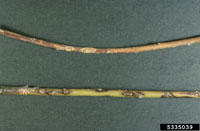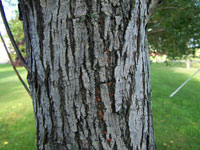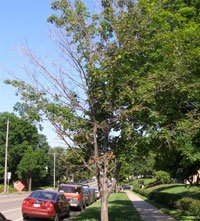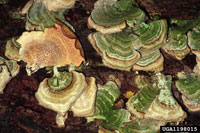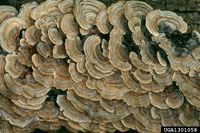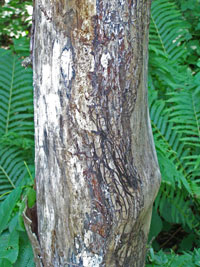Extension > Garden > Diagnose a problem > What's wrong with my plant? > Deciduous Trees > Willow > Leaves are wilted and discolored
Willow > Leaves > Leaves are wilted and discolored
1 of 4
Willow blight
Ventura saliciperda and Glomerella miyabeana
- Young leaves turn black, shrivel and fall off as buds open in spring
- Shoots turn black, wilt, curl over and die
- Small, black, sunken cankers form on twigs causing twig dieback and shoot blight
- Infection from V. saliciperda limited to new shoots; G. miyabeana may infect older twigs
- Common in cool, wet weather
- More information on Willow blight
2 of 4
Valsa canker
Valsa sordida
- Leaves on random branches wilt, turn yellow then brown
- Random dead branches seen throughout the canopy
- Sunken irregulary-elongated cankers with cracked bark at the edges occur on branches or the main trunk
- On thick barked trees, cankers may not be visible
- In wet weather curled tendrils of orange spores emerge from pimple-like fungal structures within infected branches
- Common on trees stressed by drought, winter injury, wounds, insect feeding or other factors
- More information on canker
3 of 4
Sapwood rot
Schizophyllum commune, Cerenna unicolor, Trametes versicolor
- Dead branches within the canopy
- Yellowing to brown leaves may be present
- Groups or rows of small (
- Schizophyllum shelf fungi are white and appear fuzzy on top
- Cerrena fungi are white to greenish grey and have concentric rings on the surface
- Trametes shelf fungi are tan to brown with darker rings
- Wood below fungal shelves is yellowish to white, spongy, crumbly and decayed
- Bark around fungal shelves is killed and often falls off
- Common on trees stressed by drought, winter injury, wounds, mechanical injury or other factors
- More information on Heart rot
4 of 4
Armillaria root rot
Armillaria spp.
- Infected trees have poor growth, dead branches in the upper canopy, undersized and/or yellow leaves
- Flat white sheets of fungal growth (mycelial fans) between the bark and sapwood at the base of infected trees
- Thick black, shoestring-like fungus can sometimes be seen under the bark, around roots and in the soil around the base of the tree
- Wood is decayed, white, soft and spongy; this may extend from the base of the tree well up into the trunk
- Trees frequently break or fall over in storms
- Clusters of honey-colored mushrooms may grow at the base of the tree in fall
- More information on Armillaria root rot




